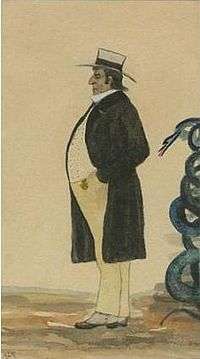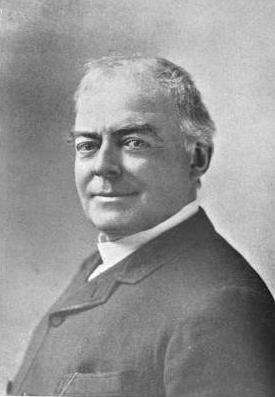William J. Le Moyne
| William J. Le Moyne | |
|---|---|
|
Circa 1890s | |
| Born |
April 29, 1831 Boston, Massachusetts, U.S.A. |
| Died |
November 6, 1905 (aged 74) New York City, New York, U.S.A. |
| Occupation | Stage Actor |
| Years active | 1852–1901 |
William J. Le Moyne(1831–1905) was an American actor who is credited with playing Deacon Perry in the first stage adaption of Harriet Beecher Stowe's anti-slavery novel, Uncle Tom's Cabin.
Early career
William J. Le Moyne (sometimes spelled Lemoyne or LeMoyne) was born on April 29, 1831 in Boston, Massachusetts[1][2] where he began performing in amateur theater productions at around the age of fifteen.[3] Le Moyne may have briefly supported himself as a silversmith[4] before his professional stage debut on May 10, 1852 at Portland, Maine playing an officer in The Lady of Lyons, a romantic drama by Edward Bulwer-Lytton.[5] Later that year Le Moyne joined the repertory company at Peale's Museum in Troy, New York, as a $6 a-week 'utility man' (bit player) that was later increased to $8 after he demonstrated an ability to play 'old man roles'. The company was largely made up of friends and family of its manager, George C. Howard and is remember for staging the first production of Uncle Tom's Cabin on September 27, 1852 at Peal's Museum.[6] The play was an immediate hit and had a run of one hundred performances, remarkable at the time for a community the size of Troy. Le Moyne's tour with Uncle Tom's Cabin the following year paved the way for his one-day becoming an actor of national standing.
Military Service
At the outbreak of the American Civil War Le Moyne enlisted as a first lieutenant with Company B of the 28th Massachusetts Volunteers under the command of fellow actor Lawrence Barrett. At some point Barrett resigned and Le Moyne assumed command only to witness over half his men killed or wounded in a string of Northern defeats in South Carolina and Virginia. In September 1862, Le Moyne himself was severely wounded during the Battle of South Mountain and was unable to return to military service. He was later granted by congress a retroactive promotion to the rank of captain dating back to the point he assumed command of company B.[7]
Career
In 1863 Le Moyne returned to the stage where he remained active until the dawn of the twentieth century. He appeared in a number of plays based on the works of Charles Dickens playing such characters as Fagin, Captain Cuttle, Uriah Heep, Squeers, Plummer, Dick Swiveller and Caleb. In Shakespeare's Hamlet Le Moyne is said to have played every major male role except that of the prince himself. Over his career Le Moyne performed with companies headed by legendary actors Edwin Booth, Edwin Forrest and Charles Fletcher, and in producer Daniel Frohman's Lyceum Theatre Company.[8] Heart trouble forced Le Moyne to retire from the stage in 1901 after supporting James K. Hackett in Don Caesar's Return.

Marriage
His first marriage to actress Sarah Le Moyne ended in divorce in 1886 or 87. He married his second wife, actress Sarah Emma Cowell, in June 1888 [9] and remained with her until the end of his life. Sarah, who was an accomplished actress and reader at the time of their marriage, went on to have a successful Broadway career under her married name.

Hobbies
Le Moyne was an eclectic collector whose house was adorned with paintings of Chinese actors, old plaques, a variety of smoking pipes, an idol from a Chinese temple, antique children's shoes, artifacts from several ancient American and Asian cultures and works by contemporary American artists. He had also gathered a large assortment of horseshoes, his favorite being one he found in New York City on Thirteenth Street one Friday with seven nails still attached. Le Moyne's most valuable collection would come from a lifelong passion for obtaining old and rare books. Offstage Le Moyne was also known as a painter in the medium of water colors.[10]
Death
William J. Lemoyne died after several years of declining health on November 6, 1905, at a friend's residence in Inwood-on-the-Hudson[11] (now Inwood), a neighborhood on the northern shore of Manhattan Island.
Plays
| 1852 | Lady of Lyons | First Officer |
| 1852 | Ingomar | Friar Lawrence, Sir Oliver Surface, Eugene Delorme and Polydore |
| 1852 | Uncle Tom's Cabin | Deacon Perry |
| 1891 | Old Heads and Young Hearts | Jesse Rule |
| 1887 | The Wife (play) | Major Homer Q. Putnam |
| 1872 | The Provoked Husband | John Moody |
| 1889 | London Assurance | Sir Harcourt Courtly |
| 1872 | Article 47 | Old Simon |
| 1872 | Road to Ruin | Silky |
| 1872 | The Inconstant | Caius |
| 1882 | Manhood (play) | Peter Sharpley |
| 1885 | Saints and Sinners | Deacon Samuel Hoggard |
| 1883 | The Rajah | Joseph Jeckyll |
| 1883 | Sealed Instructions | Mons Cervais |
| 1889 | The Charity Ball | Ex-Judge Peter Gurney Knox |
| 1888 | Sweet Lavender | Barrister Dick Phenyl |
| 1891 | Lady Bountiful | Rederick Heron |
| 1895 | The Case of Rebellious Susan | Admiral Darby |
| 1895 | The Private Secretary | Lord Blayver |
| 1886 | Jim, the Penman | Baron Hartfeldt |
| 1896 | The Benefit of the Doubt | Fletcher Portwood |
| 1872 | Divorce | Detective Burritt |
| 1892 | Squire Kate | Gaffer Kingsley |
| 1886 | Our Society | Reginald Rae |
| 1898 | Catherine | M. Vallon |
| 1900 | The Choir Invisible | Rev. James Moore |
| 1900 | Naughty Anthony | Adam Budd |
| 1898 | The Moth and the Flame | Mr. Dawson |
| 1897 | The Coat of many Colors | Florian Walboys |
| 1898 | Tess of the D'Urbervilles | John Durbeyfeld |
| 1897 | Roaring Dick and Co. | Mr. Pontifax |
| 1900 | Don Caesar's Return | Marquis of Gonzalo |
References
- ↑ Players of the present, Volume 1 By John Bouvé Clapp, Edwin Francis Edgett
- ↑ The National cyclopedia of American biography, Volume 5, 1894
- ↑ Players of the present, Volume 1 By John Bouvé Clapp, Edwin Francis Edgett
- ↑ 1850 US Census records
- ↑ answere.com
- ↑ Troy, NY: A Collar City History By Don Rittner.
- ↑ Famous American actors of to-day By Charles Edgar Lewis Wingate 1896
- ↑ A History of the New York Stage From the First Performance in 1732 to 1901, vol. III, by Thomas Allston Brown, 1903
- ↑ The National Cyclopaedia of American Biography (Volume 13). James T White & Company. 1906.
- ↑ Famous American actors of to-day By Charles Edgar Lewis Wingate 1896
- ↑ The New York Times –November 7, 1905
| Wikimedia Commons has media related to William J. Le Moyne. |
